تسهل مكونات OHS استخدام FHIR. يمكنك استخدامها بشكل منفصل أو دمجها لتشكيل أساس لمنصة صحية رقمية شاملة.
تطبيقات Android المستندة إلى FHIR
باستخدام Android FHIR SDK، يمكن للمطوّرين إنشاء تطبيقات Android أصلية بسرعة في ميزة FHIR. حزمة SDK عبارة عن مجموعة نموذجية من المكتبات المصممة لتوفير المرونة لمجموعة من حالات الاستخدام المختلفة. وتشمل هذه الطرق استخدام:
- مكتبة التقاط البيانات المنظمة في تطبيق حالي لتفعيل جمع البيانات عبر FHIR،
- FHIR Engine Library لإنشاء حلول أولية في وضع عدم الاتصال على FHIR
- الإمكانات المتقدمة في مكتبة سير العمل لإتاحة دعم القرارات السريرية المستندة إلى CQL من محتوى الإرشادات الذكية لمنظمة الصحة العالمية (WHO).
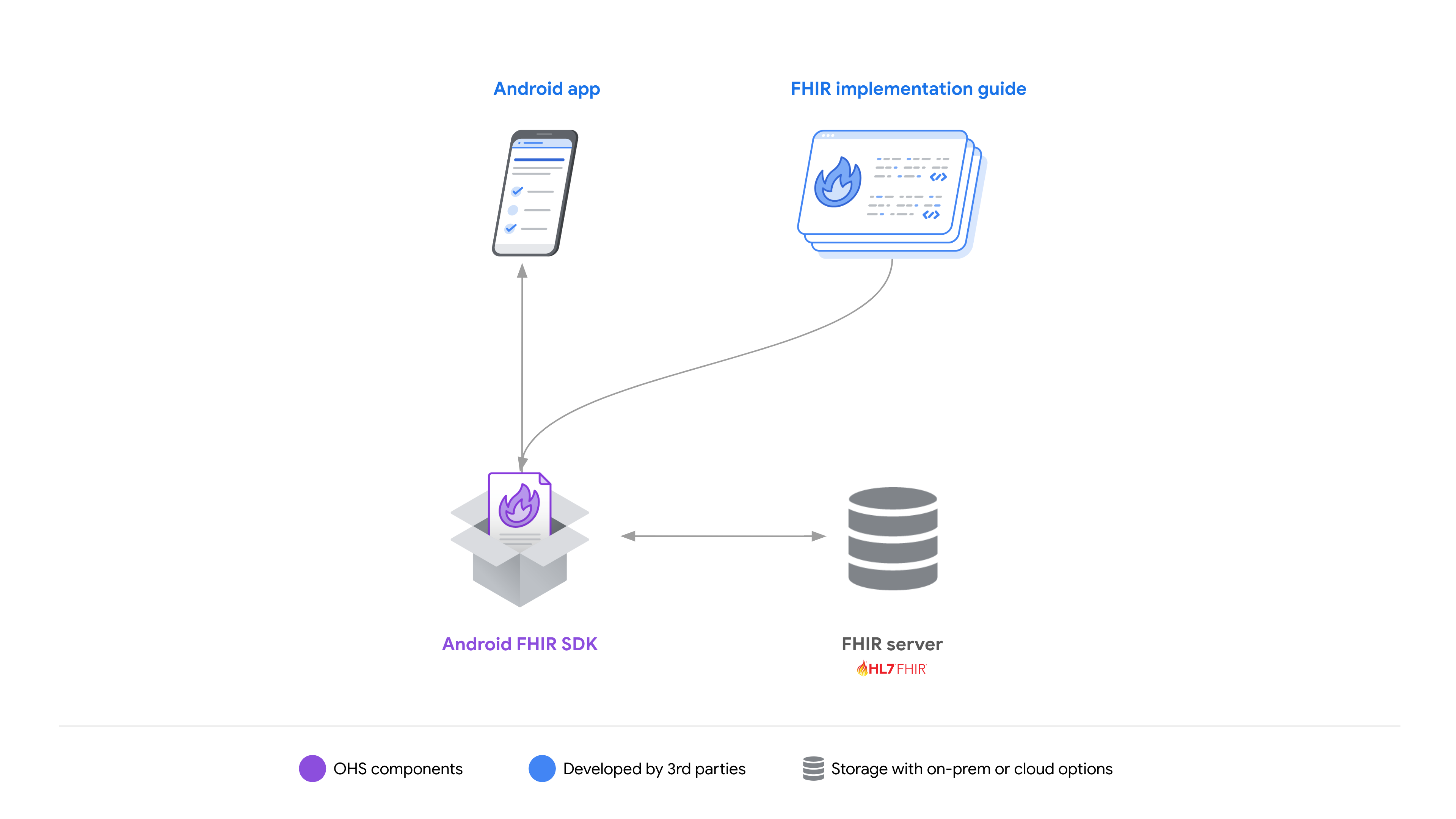
المصادر:
- يمكنك البدء بسرعة باستخدام الدرس التطبيقي حول ترميز SDC.
- اقرأ المزيد عن كيفية تطوير المطورين لحلول الأجهزة الجوّالة باستخدام OHS.
تحسين الخصوصية والاستفادة من SMART-on-FHIR
بوابة معلومات FHIR هي خادم وكيل عكسي مستقل يمكنك نشره أمام أي تطبيق لتحسين الخصوصية وتسهيل تنفيذ سياسات التحكم في الوصول التنظيمية. وعند استخدامها مع تطبيق Android FHIR SDK، يمكن لبوابة المعلومات أيضًا تحسين عمليات المزامنة، على سبيل المثال، للحد من بيانات المريض التي يمكن لعامل صحي محدّد تنزيلها والوصول إليها عند العمل بلا اتصال بالإنترنت.
وكخادم وكيل مستقل، تدعم بوابة المعلومات التكامل مع تطبيقات SMART-on-FHIR.
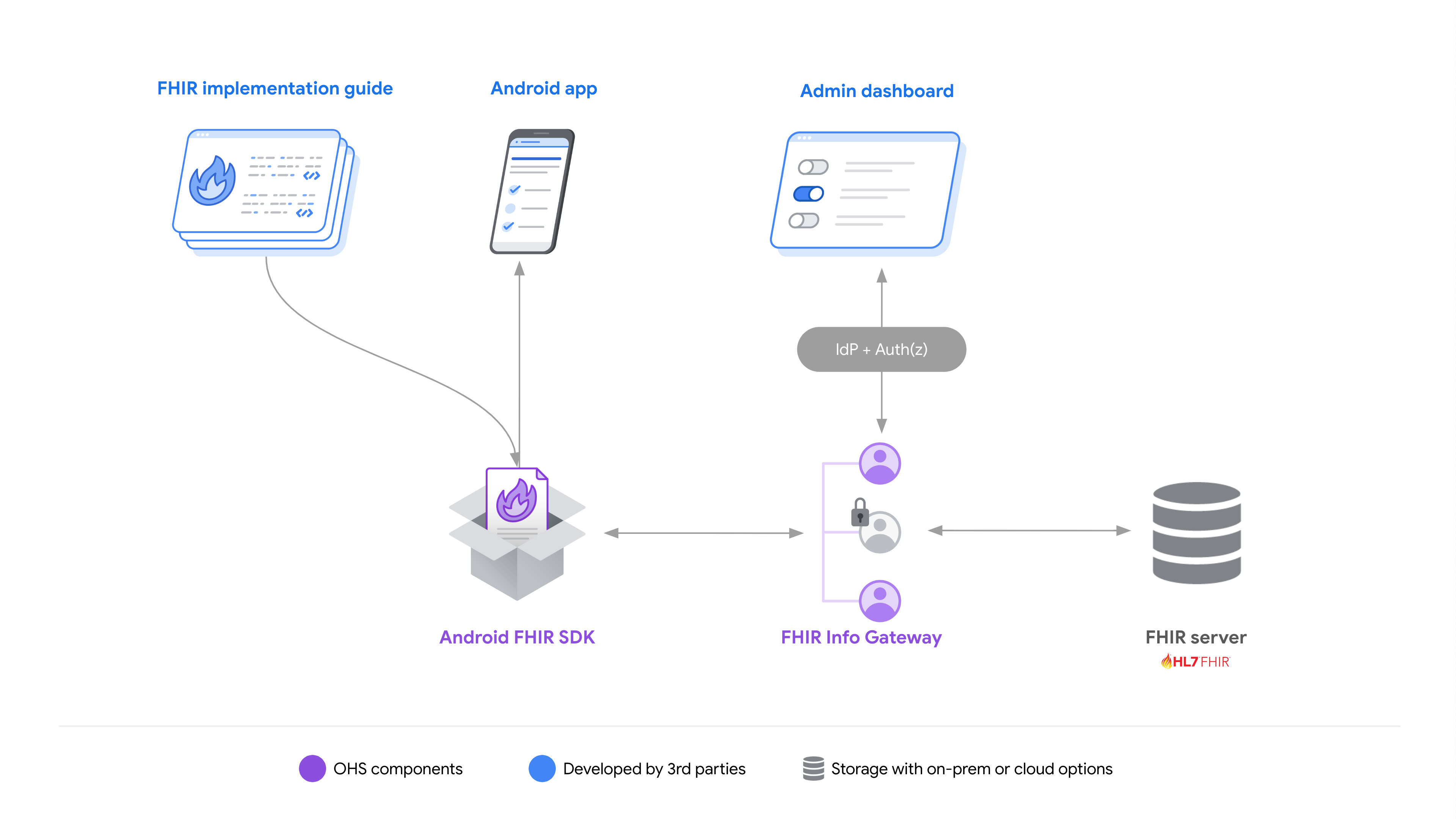
المصادر:
- يمكنك استكشاف مستودع أمثلة تطبيق FHIR للاطّلاع على طريقة استخدام بوابة معلومات FHIR مع مكوّنات OHS الأخرى.
حلول إحصاءات FHIR
نظرًا للبنية المتداخلة بشدة لبيانات FHIR، قد يكون كتابة الاستعلامات لإنشاء رؤى أمرًا صعبًا. تبسّط FHIR Data Pipes المشكلة من خلال مسار ممر سهل النشر وقابل للتوسع أفقيًا يحول بيانات FHIR إلى تنسيق SQL-on-FHIR، ما يتيح الاستعلام عن بيانات FHIR عبر SQL.
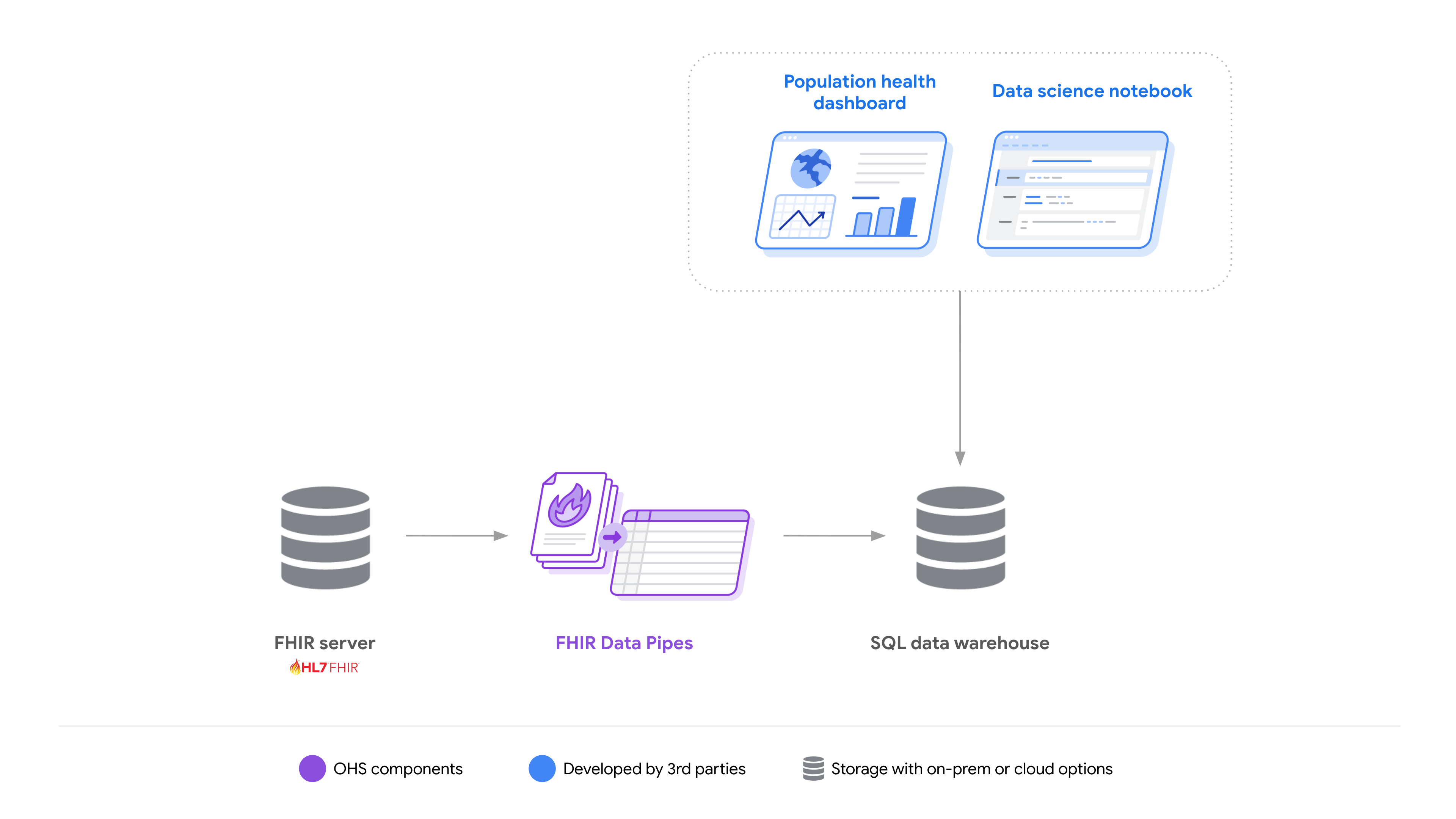
يمكن أن تكون FHIR Data Pipes مفيدة حيث يكون FHIR مصدر البيانات المراد تحليلها. تشمل السيناريوهات الشائعة للمطوّرين ما يلي:
- كامتداد لحلّ FHIR الأصلي المتعلّق بالصحة على الأجهزة الجوّالة، يمكنك الاطّلاع على أساسيات حلّ شامل للصحة الرقمية.
- كجزء من حلّ تحليلي مستقل يستفيد من FHIR: اطّلِع على مثال على البنية المختلطة.
المصادر:
- يمكنك البدء بسرعة من خلال البرنامج التعليمي لنشر جهاز واحد.
- يمكنك استكشاف مستودع أمثلة تطبيقات FHIR للاطّلاع على كيفية استخدام أنابيب بيانات FHIR مع مكوّنات OHS الأخرى.
أسس إطلاق حلّ رقمي شامل للصحة
يوفر استخدام جميع مكونات OHS معًا أساسًا للمطورين لبناء منصات أو حلول مستندة إلى FHIR. من خلال توفير عدد من الميزات الأساسية، مثل إمكانات المزامنة بلا اتصال بالإنترنت، وتقليل التعقيد التقني للعمل مع FHIR، يمكن للمطوّرين توفير وقت كبير والتركيز بشكل أكبر على القيمة المضافة للحلول.
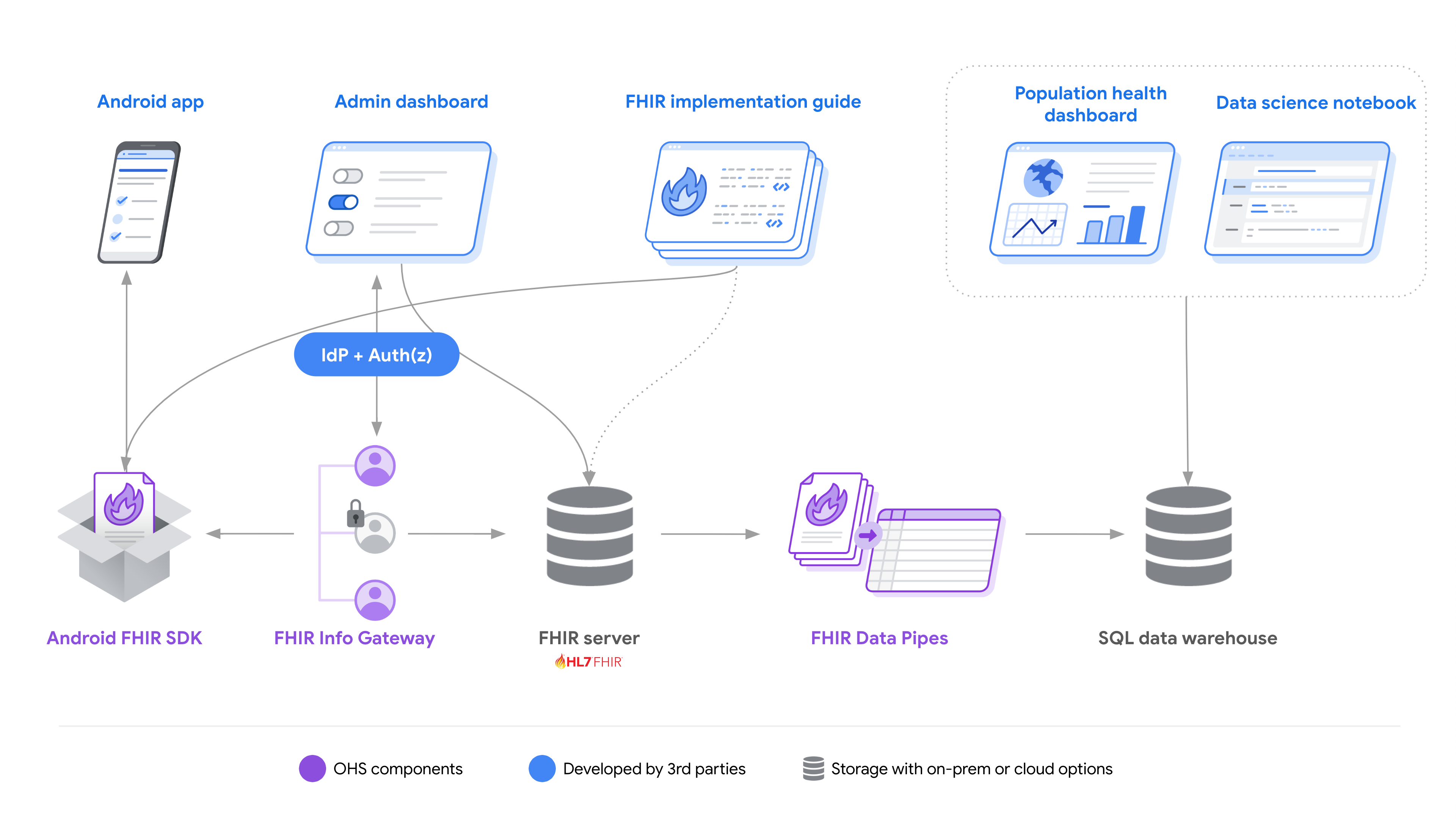
المصادر:
- استكشِف مستودع أمثلة تطبيق FHIR لمعرفة طريقة استخدام جميع المكوّنات معًا.
- اقرأ كيف استخدم "أونا" نظام OHS لإنشاء OpenSRP FHIRCore.
مثال على البنية الهجينة
تتيح وحدة مكونات OHS للمطورين انتقاء واختيار القطع التي تساعدهم على أفضل وجه في حل مشكلات محددة.
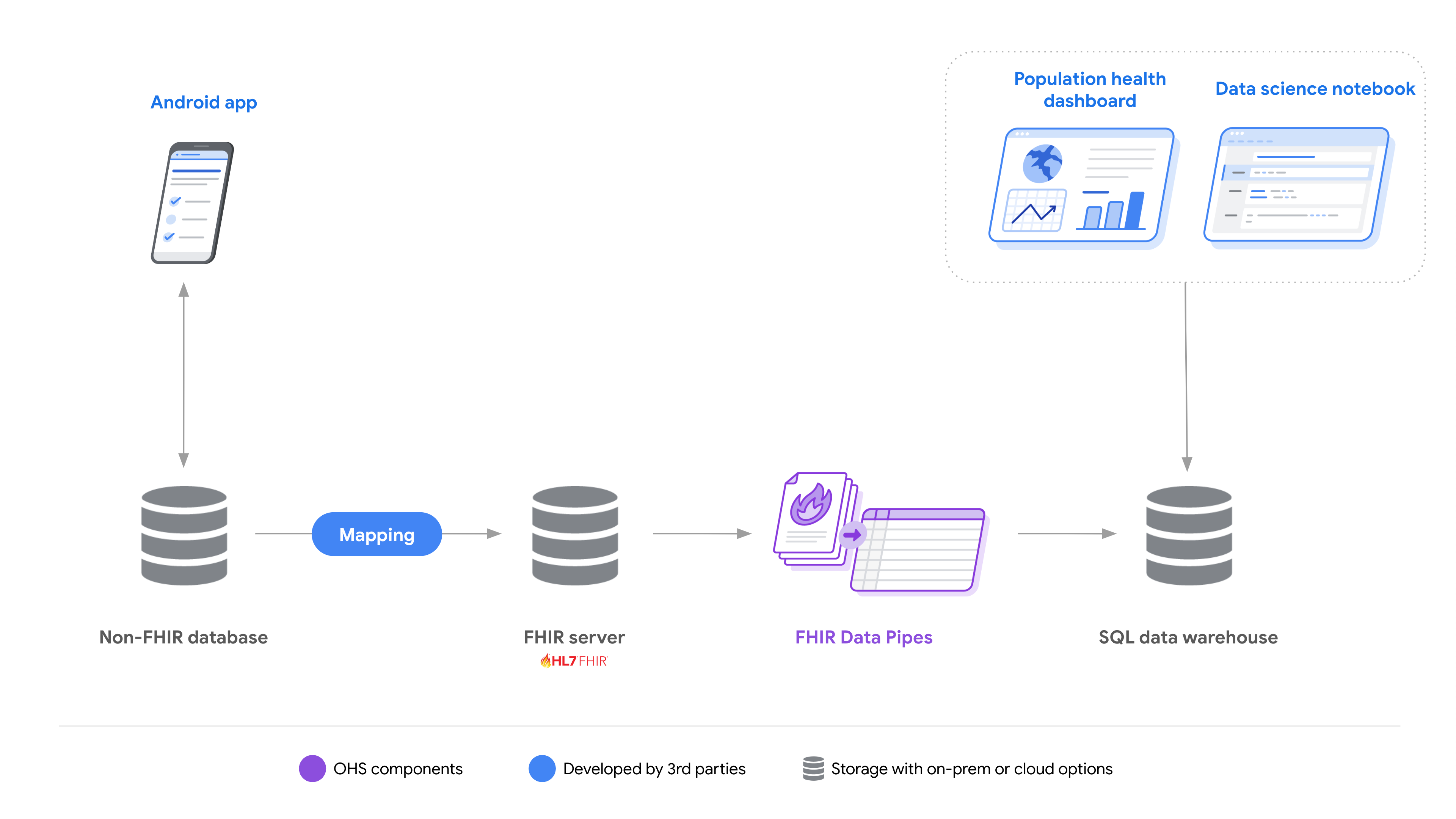
هناك العديد من الأمثلة على الحالات التي قد يكون من المفيد فيها نقل جزء من نظام حالي إلى FHIR مع الحفاظ على أجزاء أخرى من الحل كما هي. وتشمل هذه المعلومات ما يلي:
جمع البيانات بخلاف FHIR إلى التحليلات المستندة إلى FHIR: في هذا السيناريو، تتحول البيانات المجمّعة بطريقة غير FHIR إلى FHIR لتفعيل استخدام أنابيب البيانات OHS FHIR لتحقيق نهج مشترك للحصول على إحصاءات من بيانات FHIR. لتحويل البيانات، يمكن للمطوّرين استخدام واجهات برمجة تطبيقات المورّدين الحالية أو الخدمات الحالية التابعة لجهات خارجية، مثل السلع العالمية المعتمَدة OpenFn أو الاستفادة من المشاريع مفتوحة المصدر ذات الصلة.
تطبيق FHIR الأصلي لأنظمة غير FHIR: في هذا السيناريو، يتم استخدام تطبيق FHIR أصلي للجوّال تم إنشاؤه باستخدام حزمة Android FHIR SDK لتقديم الرعاية الصحية بلا اتصال بالإنترنت مع مزامنة البيانات مع خادم FHIR. ويمكن لمطوّري خوادم FHIR تنفيذ عمليات الدمج مع الأنظمة الحالية أو المحوِّلات التابعة لجهات خارجية أو الرموز المخصّصة.
المصادر:
- استكشِف مستودع أمثلة تطبيق FHIR لمعرفة طريقة استخدام جميع المكوّنات معًا.

